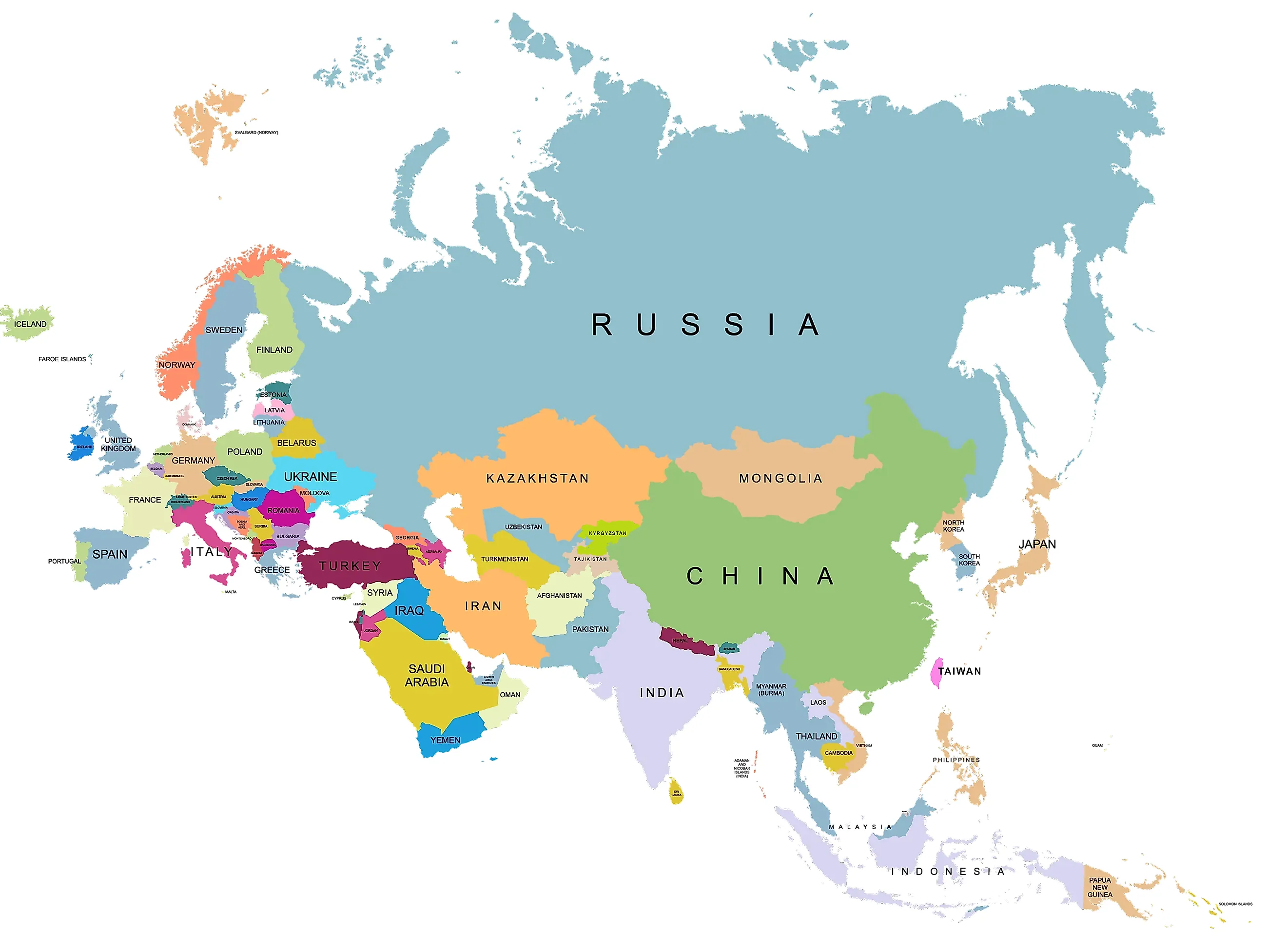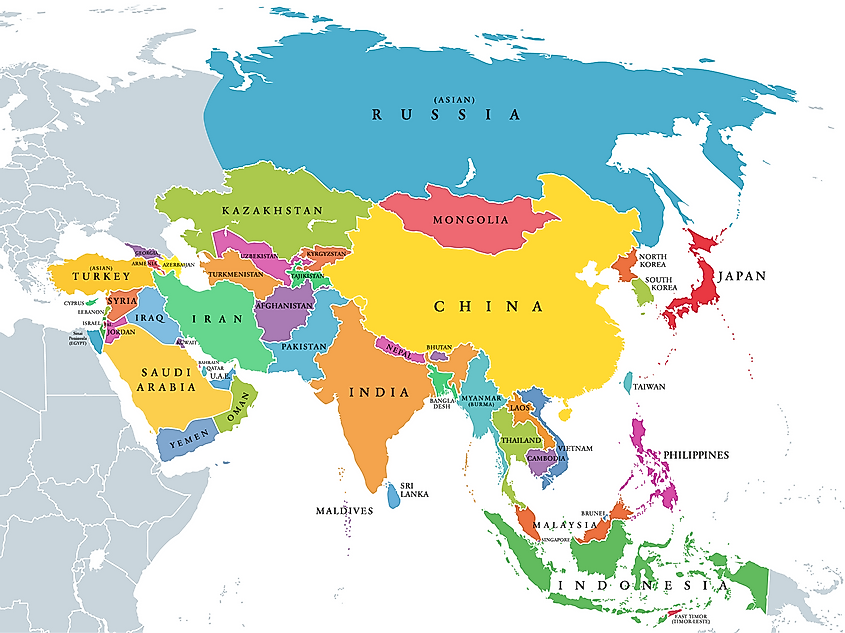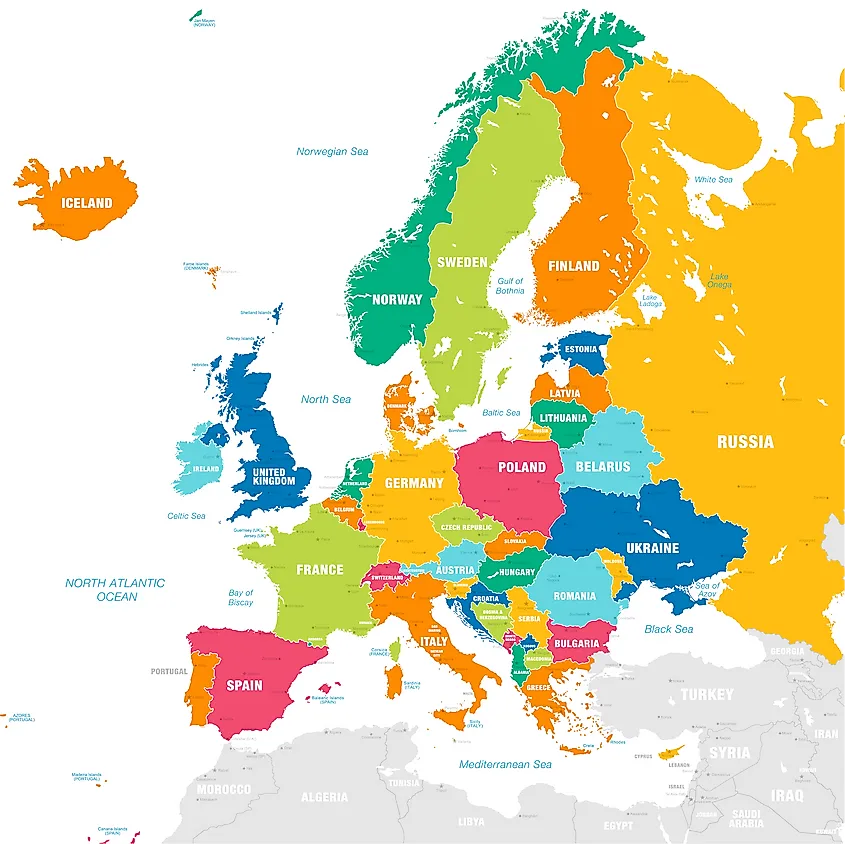
Eurasia
The Planet Earth is divided into regions known as continents. Some continents, such as Africa, Antarctica, and Australia, are distinct and separate, with clear demarcations and boundaries. However, continents such as South America and North America and Asia and Europe often come into question whenever they are mentioned, mainly because of their geography and geopolitical history. Europe and Asia form one large continental area known as Eurasia. The Eurasia continent sits almost entirely on the Eurasian plate, except for Arabian and Indian subcontinents and some areas near the Chersky Range. The Eurasian plate indicates clearly that there is no geologic boundary between Asia and Europe.

Origin And Meaning Of The Name
The name “Eurasia” is derived from two words, “Eur” from Europe and “asia” from Asia. Europe and Asia are the two continents making up the larger continental area of Eurasia. In ancient times, the area, now considered Eurasia, was one large continuous landmass, extending from the shores of the Pacific Ocean to those of the Atlantic Ocean. The region was divided into two areas; eastern and western regions, with the Black Sea and the Sea of Marmara as the border between them. Later, the Greeks named the western portion as Europe and the eastern as Asia.
The name “Europe” was derived from the name of a Greek mythological princess known as “Europa.” Geographers such as Strabo used the name Europe to refer to the region below the Balkan Mountains. Also, the name “Asia” was derived from a Greek mythological woman, known as “Asia,” who was one of the daughters of Tethys and Oceanus.
The Eurasian Geopolitical Concept
Eurasia is a highly contested and debated term, with different perceptions and meanings. However, it has two broad meanings; geopolitical and geographical meanings. Geographically, Eurasia is a place, location, or space occupied by the continents of Asia and Europe. That is, all European and Asian territories are referred to as Eurasia. Geopolitically, the term is more complicated and complex, with deferring views and perceptions, often contradictory and conflicting. However, the Eurasian concept was first used in imperial Russia, before being adopted for wider use.
Geopolitically, the term “Eurasia” is rooted in various classical concepts and theories, particularly “pivot” and “heartland” concepts fronted by Sir Hartford Mackinder. He referred to the large area east of the Urals as “Pivot” and argued that whoever will control this huge landmass will have control over global politics.
Russian Eurasianism concept is still very much alive and powerful, with the main aim being integrating with other countries considered to be part of Eurasia. In Turkey, Eurasia is restricted to areas inhabited by the Turkic people, such as modern-day Turkey, parts of Central Asia, the former USSR region, and the Balkans. For Kazakhstan, Eurasia is a term used to describe the country’s location. Geographically, the landlocked country of Kazakhstan is located in continental Asia, with less than 10% of the territory extending into Europe. However, geopolitically, it is one of the Eurasian states. Thus, it considers itself as a “bridge” between the two continents. But, Kazakhstan Eurasianism is also an ideology whose focus is on building unity, solidarity, and peace among people. The word “Eurasia” or Eurasian” also appears in the names of numerous institutions, including the Eurasian Bank, Eurasian Media Forum, L. N. Gumilev Eurasian National University, and Eurasian Cultural Foundation.

Extent
Eurasia can be defined as a region comprising the continents of Europe and Asia. It is a region in the Eastern and Northern Hemisphere, extending from the Atlantic Ocean, with Spain and Portugal on the west, to the Bering Strait in Russia. The region is bordered to the east by the Pacific Ocean, west by the Atlantic Ocean, north by the Arctic Ocean, and south by the Indian Ocean, the Mediterranean Sea, and Africa.
Eurasia spans over 55 million square kilometers or approximately 36% of the Earth’s land area. The northern portion comprises Norway, Finland, and Russia, while countries on the southern border include India, Israel, Spain, Yemen, and Malaysia. The region also includes the islands associated with the Eurasian plate, such as Japan, Sicily, Malaysian islands, Crete, the Philippines, and maybe Indonesia.
Eurasia and Africa are connected by the Suez Canal. The canal is an artificial waterway connecting the Red Sea to the Mediterranean Sea and dividing Asia from Africa. The two landmasses sometimes combine to form one large continental area known as Afro-Eurasia.

History
Eurasia is estimated to have formed 375-325 million years ago, following the merging of Laurentia with the Baltica, Kazakhstani, and Siberia geological regions. The concept of Asia and Europe, as distinct continents, was introduced by the Greeks during antiquity. The border between the two continents was defined as the Sea of Marmara, the Black Sea, and their associated straits. However, the Caucasus and the Ural Mountains are considered the modern boundaries between the two continents. The Eurasian region has been the site of several civilizations, including those of the Indus Valley, Mesopotamia, and China. Numerous fierce historical battles were also fought in the continental region, including the Greco-Persian War, Russo-Persian War, and Roman-Parthian War.
Demography
As of 2012, the Eurasia region comprised 92 sovereign countries, of which 44 are European countries and 48 are Asian countries. Thus, the continental area accounts for close to half of the world’s sovereign countries.
Eurasia was first occupied about 125,000 years ago. As of 2019, the region has an estimated population of 5.4 billion (about 71% of the world’s total population). The region's population includes 746 million people in Europe and 4.6 billion people in Asia. Seven of the world’s ten most populated countries are within the Eurasia area, with China and India accounting for about 52% of the region’s population.
Regional Alliances And Cooperation
Different Eurasian countries have come together to form several common markets, including ASEAN Economic Community, Eurasian Economic Space, Gulf Cooperation Council, and other international organizations. Since 1996, most European and Asian counties have been holding consultative meetings every two years know Asia-Europe Meeting (ASEM). Other alliances and organizations in the region are the Eurasian Union, Russia-EU Common Space, and the Commonwealth of Independent States.











